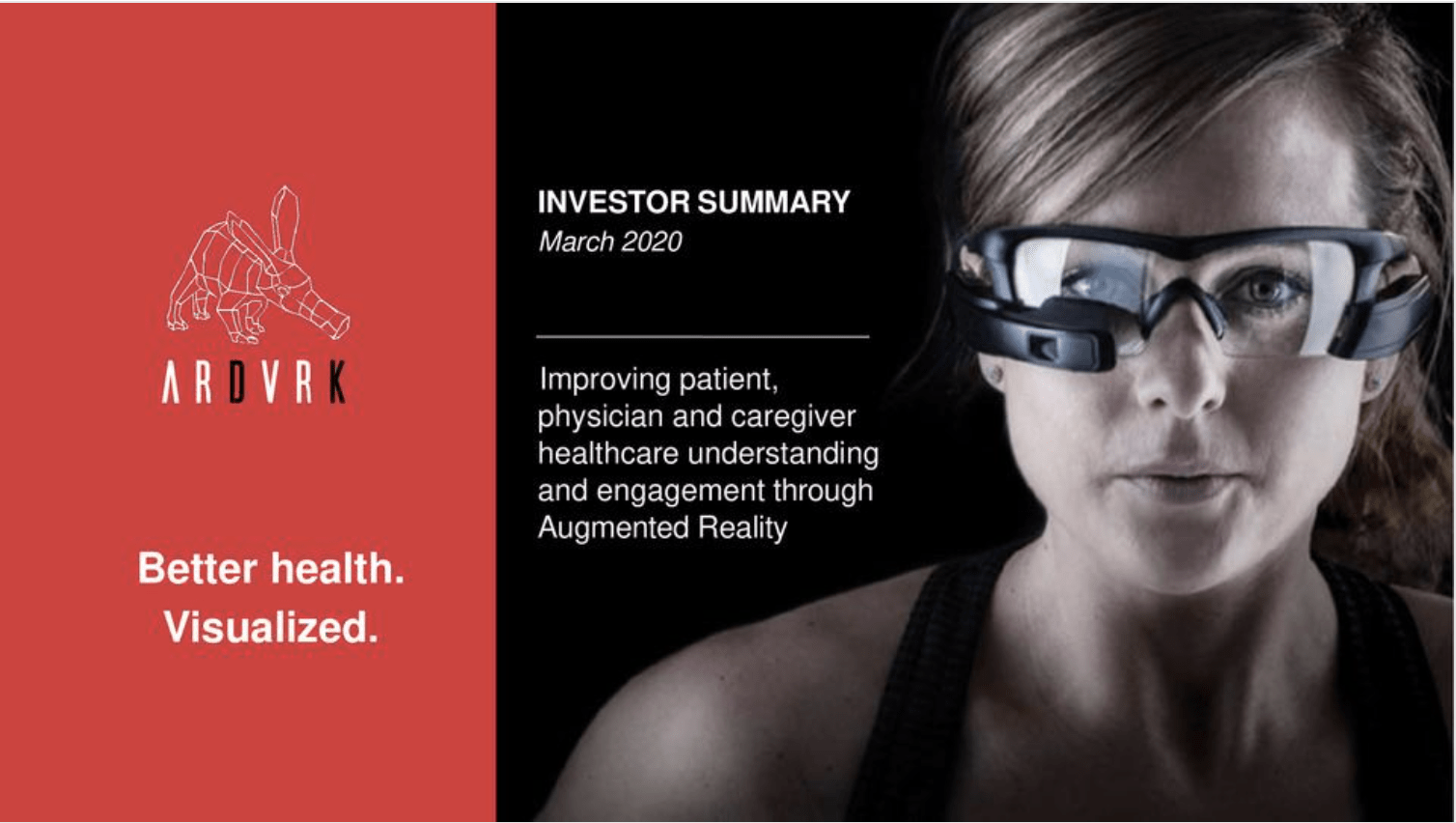Deal Abstract
https://www.seedinvest.com/ardvrk.technologies/seed
Augmented Reality (AR) and Virtual Reality (VR) studio and distributor for medicine. The platform is called “Vital Recall.” Simply put: this company makes AR and VR experiences to help you visualize and understand the human body in a variety of settings, such as during clinical trial. Has revenue, solid valuation, large customers such as AstroZeneca and others.
The 6 Calacanis Characteristics (91 161 18)
| Check | Pass/Fail |
| 1. A startup that is based in SV | Fail: Princeton NJ on LinkedIn, Austin TX when looking for a job. |
| 2. Has at least 2 founders | Pass (3), maybe, at least 2 C-suite. (CEO, CTO, Mike O’Brien.) |
| 3. Has product in the market | Pass |
| 4. 6 months of continuous user growth or 6 months of revenue. | Pass: 2018 Revenue was $257k, 2019 Revenue was $436k. |
| 5. Notable investors? | Fail: None that I recognize but I’m not a deep expert in this space. That said, they did highlight Notable advisors include Bill Mezzanotte, (MD,) Executive Vice President, Head Research & Development at CSL Behring. YouTube interview was friendly and gracious, so redemption credit. |
| 6. Post-funding, will have 18 months of runway | Pass: Raising $2.5 million, current burn is 37k, confirmed will have 67 months of runway at present spend. |
The 7 Thiel Questions (ETMPDDS)
- The Engineering question:
- Interesting: Came in wanting to hate on AR/VR businesses since there hasn’t been one yet. Magic Leap has raised 2.6 million over 9 rounds and still hasn’t shipped a product. That said, these guys are convinced that going medicine first (as opposed to tech first,) will be the reason for their success.
- The Timing question:
- Bad: would love to see more success in AR/VR, but there’s always got to be the “first person to eat crab.”
- The monopoly question:
- Yes: Assuming you can solve for the complex software engineering and ability to deploy this on mobile devices everywhere, for sure, why would you have two medical education AR/VR apps? Unless this was a content play like NetFlix/HBO Go and Max/Disney+? Maybe in the future AR/VR enters this industry but for now I think it’s most white glove service, case by case, as each educational experience is tailored.
- The people question:
- The distribution question:
- Good: This has to be ARdVRk’s advantage vs. tech companies. Peerschke needs to tap relationships and sell to risk-averse biotech executives.
- The durability question:
- Excellent: If they can build it, this industry is very risk-averse and probably won’t change.
- *What is the hopeful secret?:
- Healthcare providers (and end customers, sort of,) really drive unambiguous value from being able to visualize and learn from 3d AR/VR biomedical educational apps. To be honest, I thought this was a nice-to-have, not a need-to-have, but if the technology is cheap and helpful enough, it may raise the standard of medical education then become solid.
What has to go right for the startup to return money on investment:
- Scale, baby, scale: if this company just becomes a studio for making custom AR/VR apps, then it will never grow fast enough. The way to solve this is probably to team up with medical education companies at some point (McGraw-Hill for medicine,) and get some kind of equity/revenue sharing.
- DIY-Alternative: really make this SaaS. I imagine it would be challenging to build the AutoCAD of medical education, but that would certainly be a very healthy B2B SaaS company.
- Turn Into Essential: alluded to previously before, but at the moment this feels like a cool feature, rather than an urgent need. If doctors/physicians/clinicians/patients all start to lobby for this type of thorough visualization, then that’ll give pressure for adoption, whereas right now there are no downsides to companies to wait on this.
What the Risks Are
- This is not a SaaS product (yet.) As far as I can tell, this is just an app that distributes a digital AR/VR experience. Needs to become self-service.
- Timing: My initial thought at any AR/VR company is “if MagicLeap hasn’t figured this out with $2.6 billion in funding, what makes you think you can?” Is hardware the limitation? Customer age and hunger for new experiences? Or is it that the experience just isn’t good enough?
- Product philosophy: related to point one. Starting off and building a product for medicine is great and all, makes revenue. But ultimately, if you bend too much to client needs, you never build anything proprietary with high margins and scalability. AstroZeneca and the other companies are nice, but needs to keep aggressive expansion in mind so they’re a truly SaaS company and not just a vendor for AZ and co.
Muhan’s Bonus Notes
- Already raised $2.86 million.
- Has around $400k cash on hand.
- Burn 37k, margins are 38% (revenues 435k, cost of revenues 267k.)
Financials (References)
- Total Amount Raised: US $899,632
- Total Round Size: US $2,500,000
- Raise Description: Seed
- Minimum Investment: US $1,000 per investor
- Security Type: Crowd Note
- Valuation Cap: US $10,000,000
- Offering Type: Side by Side Offering
Updates
This is where I’ll post updates about the company. This way all my notes from offering to post-offering updates will be on one page.
Review these deal memos every time the startup raises a new round
Test if original thesis still applies
Notice trends in how you think


